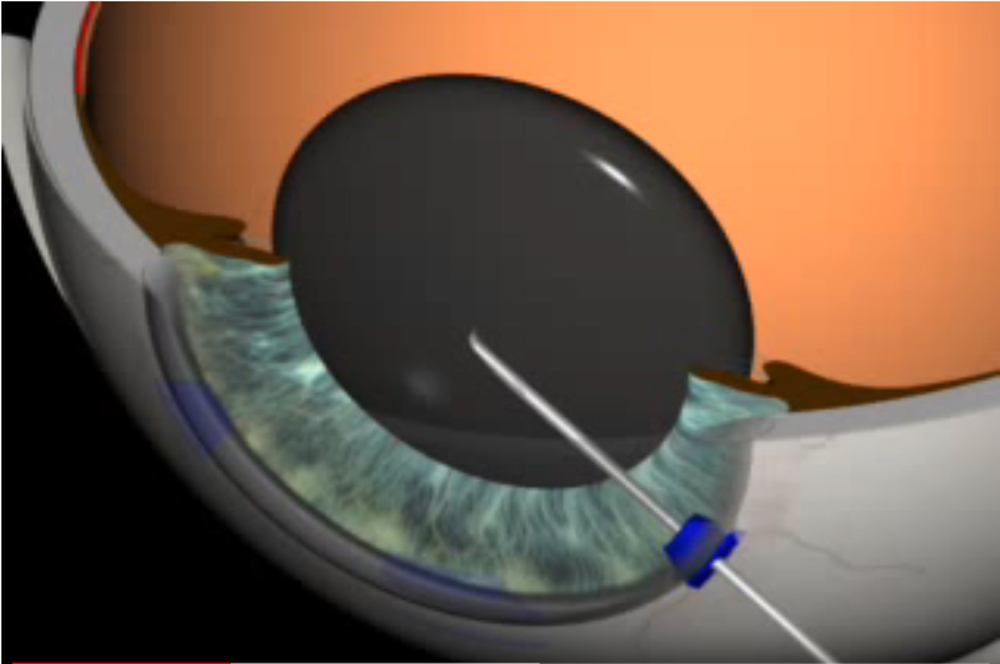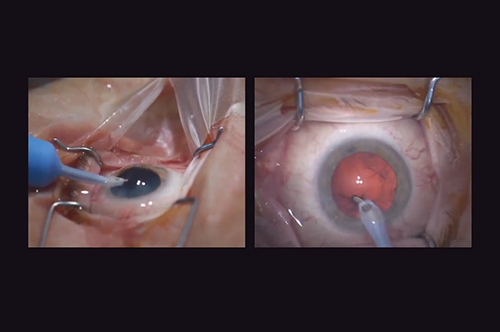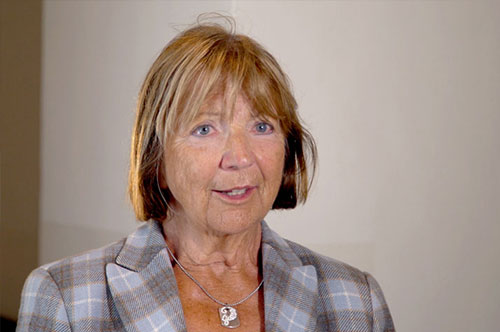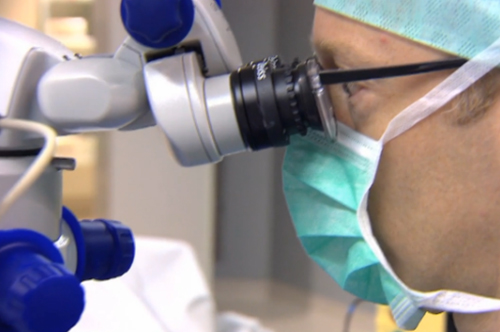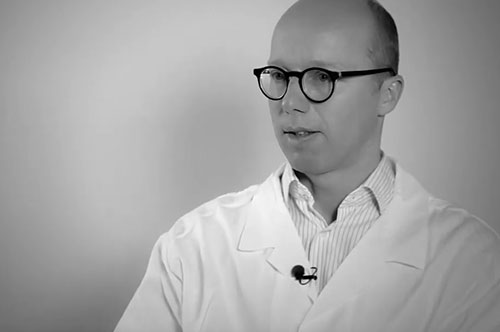Cataract is Prof. Findl’s special field. With more than 1000 cataract surgeries per year, Prof. Findl is one of the most experienced cataract surgeons in Austria. Prof. Findl is a worldwide renowned specialist in cataract surgery and has been rated No. 1 in Europe for his influential publications in the field of cataract.
Eye Surgery
Cataract
Cataract Surgery

What is a cataract?
A cataract is a progressive clouding of the eye’s originally clear lens. The most common cause for cataracts is age. This form of cataract is called age-related cataract. Most commonly, it occurs after the age of 60.
What are the symptoms of cataracts?
The most common symptoms are blurred vision, glare, increased sensitivity to light, fading colours, everything looks grey in grey, or increasing shortsightedness – “I used to be farsighted, now I am shortsighted and I can read without glasses”. If elderly patients require frequent changes in spectacle prescription, a beginning cataract may be the reason.
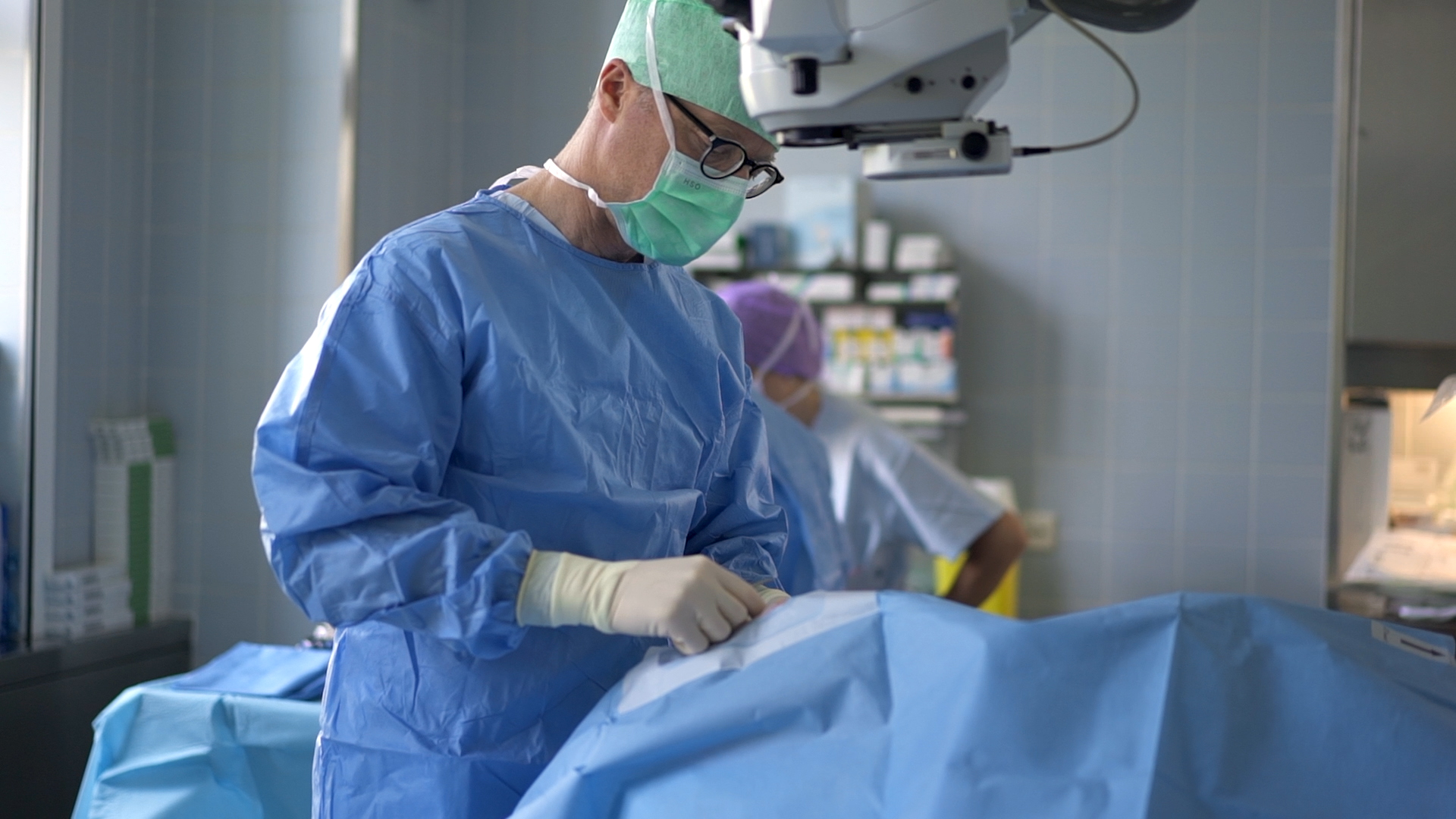
Operation
Currently, cataract surgery is the only way to treat cataract. In Vienna, Prof. Findl performs eye surgery at the Vienna Hanusch hospital and at Evangelisches Krankenhaus. For pre-examination and planning of cataract surgery, please book an appointment in our private practice.
Most frequently asked question about cataract surgery.
What happens during cataract surgery?
The lens consists of several parts: the nucleus is the central part of the crystalline lens which hardens throughout life. Surrounding it is the cortex. The entire lens is surrounded by a thin capsule which usually stays transparent. The lens is supported within the eye through thin fibers called zonules which are attached to the ciliary body.During modern cataract surgery a small cut of 2-3mm size is made at the side of the cornea. A circular opening is made into the front lens capsule.The cloudy lens substance is then liquified using high frequency ultrasound, called phacoemulsification, and is aspirated. Apart from the central round opening in the front part of the lens capsule, the capsular bag remains intact within the eye. It is polished and cleaned extensively. Then, an artificial lens is folded, inserted through the small side opening, unfolded and placed into the capsule bag. The lens implant is chosen according to the biometry measurements made before surgery. The small incision is self-sealing and usually does not require any stitches. The operation usually takes about 15 minutes.
What do intraocular lenses look like?
Intraocular lenses are usually made out of foldable plexiglass or silicone. The optical part usually has a diameter of 6 mm. In most cases, two loops that are connected to the optic ensure that the lens is centered in the capsular bag.
Does everybody tolerate intraocular lenses?
Intraocular lenses can be implanted into essentially all eyes and are tolerated very well. Only in very rare occasions it is not suitable to implant a lens.
Do I need to prepare for the operation?
Cataract surgery is usually performed under local anaesthetic. If for special reasons you should need surgery under general anaesthesia, you will need a letter from your general practitioner or internal medicine specialist stating that you are fit to undergo this kind of surgery. Please bring this letter with you on the day of surgery so that Prof. Findl can plan any extra monitoring should you require it.
In most cases, you will come to the hospital on the day of surgery a few hours beforehand. You can have your meals and any medications you are otherwise on as usual. About one hour before the actual operation you will recieve dilating eye drops and, if you wish, medication to help you relax. You will then be transported to the operating theatre in a comfortable chair.
Cataract surgery is done under topical (only eye drops) or local (small injection) anesthesia which makes the operation painless.
What is the after care?
The operated eye is covered with a shield. After surgery, you should rest a little. You do not need to stay in bed. Right after surgery, you can move around as usual. Apart from very few exceptions, cataract surgery is performed in an outpatient setting. Therefore, you may already leave the hospital 1-2 hours after surgery.
What do I have to keep in mind after cataract surgery?
Avoid rubbing or pressing on your eye. It takes a few weeks for the incision to heal permanently. Soft touching of the eye is harmless. Itching or foreign body sensations in the operated eye are normal and will disappear over time.
In general, you can return to your normal work and lifestyle routines right after surgery. You are allowed to bend over, do gymnastics, wash your hair and persue your usual activities around the house and garden. Also, watching TV and reading are allowed immediately after surgery. When you go outside into bright daylight, you may be more comfortable wearing protective sun glasses. However, sunglasses are not necessary since the implanted intraocular lens blocks harmful UV-light.
In the early days of cataract surgery, physical exercise was not permitted for months after the operation. With the latest small-incision surgery technique performed by Prof. Findl, this is no longer a problem. You are permitted to lift and carry things, you may bend over whenever you need to. After a few days, you may even use a sauna, go swimming, diving and do all types of sport.
The only exception is driving: driving a vehicle is only permitted once Prof. Findl has stated that your visual acuity is ready for safe driving. This may only be permitted after the prescription of weak spectacles, 3-4 weeks after surgery.
Taking the prescribed eye drops regularly and seeing Prof. Findl for follow-ups is important.
Which complications could occur?
If you suffer from other eye diseases, for instance prior eye surgery, corneal opacity or elevated eye pressure, the healing process might be delayed.
If you should experience any decline in your vision, increased redness or pain in your eye during the first days or weeks after surgery, you must call Prof. Findl’s private practice immediately or visit an accident & emergency eye clinic right away. A very rare infection of the inner eye (1 in 1000 cases) could be the underlying cause.
Fortunately, due to modern surgical technique, this severe complication is rare.
How does vision change after cataract surgery?
In general, you will experience a significant improvement in vision even on the first day after surgery. However, because of several reasons, you may not achieve your final visual acuity right away. Although Prof. Findl has tried to calculate the correct power of your intraocular lens, there is some variability in the outcome. After surgery, your old spectacles will not fit anymore, because one of the aims of surgery is to reduce the strength of your glasses. Sometimes, you will still need weak glasses for distance vision.
If you have been suffering from astigmatism before surgery, it is unlikely to be altered by cataract surgery and if it is, it will be only partly reduced. In those cases, corrective glasses will still be needed for optimal vision. You will also still need reading spectacles, but their strength will be reduced to thin and light glasses.
In cases of corneal astigmatism before cataract surgery of a moderate to high degree, this can be corrected with special toric intraocular lenses.
Under certain conditions, multifocal intraocular lenses may be used to achieve good vision at distance and near without the need of glasses after surgery. Nevertheless, these types of lenses also have draw backs that will be mentioned in the informed consent discussion before surgery.
First, mild irritation of the eye has to subside, using anti-inflammatory eye drops. During the first 3-4 weeks, the refractive power of your eye may change slightly. Therefore, Prof. Findl will only prescribe new glasses after a few weeks after surgery. If necessary, you will receive a prescription for temporary reading glasses.
In some cases, vision may deteriorate progressively even after 2 to 3 years: in those cases, the posterior capsule that supports the intraocular lens becomes cloudy. This condition is called an “after-cataract”. Using modern surgical technique, including thorough aspiration of the old lens and the implantation of a well chosen modern IOL, the risk of “after cataract” is reduced to about 10% of cases. This is significantly less common than a few years ago. If “after-cataract” should occur, a short outpatient laser treatment is performed and vision is normalised.
I have high myopia / hyperopia. Does the same apply to me?
Yes, it does. You, in particular, have the special advantage of getting rid of your spectacles through special calculation of the power of your artificial lens. The implanted lens can be chosen so that you will either not need glasses for distance anymore or only weak spectacles with thin glasses. In vielen Fällen ist sogar das Tragen einer Brille im normalen Tagesablauf ganz überflüssig und nur beim Autofahren oder bestimmten Tätigkeiten notwendig.
When should cataracts be operated on?
It is more or less up to the patient to decide when to have cataract surgery. It is up to you to decide whether you feel that cloudy or dull vision is interfering with your quality of life. If you have high demands regarding your vision, e.g. if you would like to drive a car, you may want to set an earlier date for surgery. Together with Prof. Findl you can decide when it is time for catract surgery. For planning possible eye surgery, please book an appointment in Prof. Findl’s private practice!
What is the prognosis?
With the latest state of the art surgical technique performed by Prof. Findl, the complication rate for cataract surgery is very low. In more than 90% of patients, a considerable improvement in visual acuity is achieved. Nevertheless, if a patient suffers from addtional eye diseases, the chances of success are reduced. Prof. Findl will inform you about the expected success of surgery for your individual case and will try to answer any of your questions.
Examinations
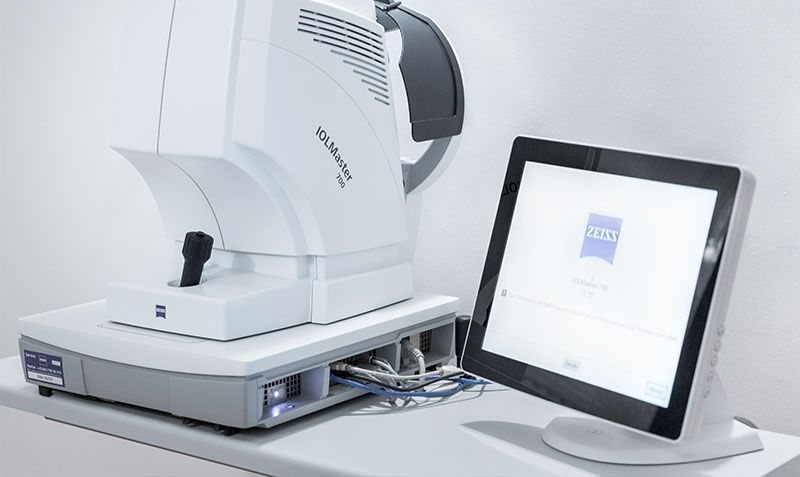
IOL Master 700: Measurement of eye length before cataract surgery
Before cataract surgery, Prof. Findl measures your eyes using the IOL-Master. This highly precise tool measures the eye length, which is important for choosing the correct power of the artificial lens. This non-contact measurement usually takes only a few minutes and is painfree.
In our office, we use the most advanced device for measuring eye length, the IOL-Master 700 with all additional modules. This new tool uses OCT Technology (SWEPT Source Biometry). This imaging technique provides highly precise measurements of eye length even in cases of dense cataracts. Additionally, measurements of astigmatism are possible. Furthermore, unusual geometry of the eye and macular degeneration may be detected.
State of the Art Device for Eye Length Measurement – the developement
In the 90’s, Prof. Findl has developed this new technology in collaboration with the Vienna Institute of Medical Physics. He has been the first clinical user of this currently prevelant technology for eye length measurement. Nowadays, the IOL-Master by Zeiss is the most frequently used tool for eye length measurement worldwide.
Special Lenses
In some cases, special lenses are used during cataract surgery.
Toric Lenses
In cases of high astigmatism of 2 diopters or more, this condition may be corrected using specially designed toric intraocular lenses. In addition to the usual IOL-Master measurement before surgery, corneal topography needs to be performed. After calculating the power of correction, the toric lens is ordered. At Hanusch Hospital, we use a newly designed surgical microscope with an in-built tracking system. This device provides precise alignment of the lens at the end of surgery.
In recent years, Prof. Findl has published several clinical studies about toric lenses in international reviews. He frequently gives lectures and holds courses about toric lenses.
Multifocal Lenses
In manchen Fällen ist der Wunsch, weniger brillenabhängig zu sein, beim Patienten sehr groß. Unter gewissen Voraussetzungen kann die Anwendung einer multifokalen Kunstlinse mit 2 Brennpunkten erwogen werden. Dadurch wird ein scharfes Sehen in die Ferne und in die Nähe ohne Brille ermöglicht. Diese Linsen haben aber einige Nachteile, wie zum Beispiel ein verringertes Kontrastsehen, stärkere Blendungsempfindung und Lichthöfe um Lichtquellen (Halos) bei Nacht. Die Vor- und Nachteile werden in einem ausführlichen Aufklärungsgespräch erläutert.
Prof. Findl hat multifokale Kunstlinsen der verschiedensten Hersteller in Verwendung und ist Autor von einigen internationalen Publikationen zu diesem Thema. Er hält regelmäßig Vorträge zum Thema Multifokallinsen auf der ESCRS, dem europäischen Kongress für Katarakt- und refraktive Chirurgie.
Films
Cataract Surgery 3D
Cataract Surgery
Cataract Surgery: Patient reports
Prof. Findl’s personal commitment for „Light for the World“
Since 2018, Prof. Findl is honorary board member of the organisation “Light for the World”. He is involved in improving life of the blind and visiually impaired. “Light for the World” enables cataract surgeries, builds hospitals and supports the training of ophthalmologists on site.
You have questions about surgery or special examinations?
Please send an email to office@findl.at including your contact phone number.
Mrs. Findl-Reiffenstuhl will call you back and answer your questions!

